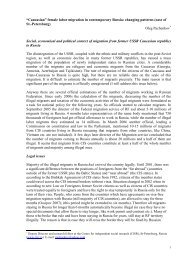THORIUM AS AN ENERGY SOURCE - Opportunities for Norway ...
THORIUM AS AN ENERGY SOURCE - Opportunities for Norway ...
THORIUM AS AN ENERGY SOURCE - Opportunities for Norway ...
Create successful ePaper yourself
Turn your PDF publications into a flip-book with our unique Google optimized e-Paper software.
Thorium as an Energy Source - <strong>Opportunities</strong> <strong>for</strong> <strong>Norway</strong><br />
turbine and, in turn, a generator to produce electricity. The steam cycle is typically 33 % efficient.<br />
A principal layout of a PWR is shown in Figure 14.2.<br />
Figure 14.2: Pressurized Water Reactor (PWR).<br />
The uranium used in PWR fuel is usually enriched several percent in U-235. After enrichment<br />
the uranium dioxide (UO2) powder is sintered to create hard, ceramic pellets. The cylindrical<br />
pellets are then put into tubes of a corrosion-resistant zirconium metal alloy (Zircaloy). The fuel<br />
rods are grouped in fuel assemblies, called fuel bundles, which are positioned in the reactor core.<br />
A typical PWR has fuel assemblies consisting of 14x14 to 17x17 fuel rods, with a length of about 4<br />
meters. A large reactor would have about 150 - 250 such assemblies with a total of 80 - 100 tonnes<br />
of uranium.<br />
Re-fuelling <strong>for</strong> most commercial PWRs is after 18 - 24 months where approximately one third of<br />
the core is replaced.<br />
Another design belonging to the light water reactor type is the Russian VVER. The reactor is of<br />
the PWR design. The fuel is low enriched (ca. 2.4 – 4.4wt% U-235) uranium dioxide (UO2) pressed<br />
into pellets and assembled into fuel rods.<br />
14.2 Appendix B2: Boiling Water Reactor (BWR)<br />
The Boiling water reactor (BWR) also belongs to the light water reactor type and is the second<br />
most common nuclear reactor in commercial operation. Today, there are 94 BWR units generating<br />
electric power accounting <strong>for</strong> about 21 % of nuclear reactors installed. BWRs use ordinary light<br />
water (H2O) both as coolant and moderator. In a BWR, water is constantly fed into the bottom of<br />
the primary vessel and then boils in the upper part of the reactor core. The steam generated, at a<br />
pressure of 70 bars and temperature around 290˚C, is routed directly to the turbine.<br />
A modern BWR fuel assembly comprises 74 to 100 fuel rods, and there are up to approximately<br />
800 assemblies in a reactor core, holding up to about 140 tonnes of uranium. Fuel load and<br />
efficiency are similar to the PWR. A schematic drawing of a BWR is shown in Figure 14.3.<br />
112

















